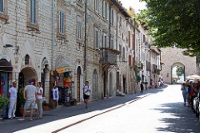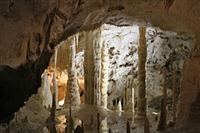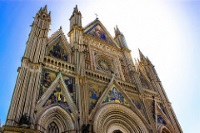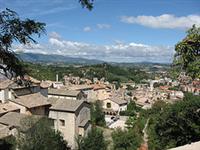
The picturesque hill town of Assisi, to the east of Perugia, is famous as the birthplace of St Francis, a 12th-century monk who founded the Franciscan order, devoted to achieving an 'abundance of the divine' through the practices of ascetism, poverty and chastity. Tourists and pilgrims flock to the bustling town for inspiration and worship, and a multitude of annual conferences, festivals and other religious activities. Assisi is a visual spectacle of shimmering white marble buildings perched halfway up Mount Subasio. The town is set against the backdrop of the towering 14th-century hill fortress of the Rocca Maggiore, a landmark with which to orientate oneself from inside the city's medieval ramparts.One of the most loved and visited churches in Italy is the 13th-century Basilica di San Francesco, containing frescoes by Giotto commemorating the life of St Francis. Other notable works include paintings by Pietro Lorenzetti, and Simone Martini's frescoes based on the life of St Martin. St Francis' tomb rests below the lower church, also worth visiting when on holiday in Assisi. Almost all of the four million tourists who travel to Assisi each year come primarily to see the Basilica di San Francesco, but other popular sights include the 13th-century Basilica di Santa Chiara, the 12th-century Romanesque Duomo di San Rufino and the Eremo delle Carceri monastery, situated in the woodland outside the walls of Assisi.Assisi is a beautiful city with winding streets, Roman ruins and magnificent churches, and it feels like it has changed little since medieval times. The greatest gems are the small medieval treasures and glorious views to be found all over the small city. It is considered a highly spiritual place and attracts many pilgrims - it is common to see nuns in the streets and there is a peaceful, ancient atmosphere.

Located just 50 miles (80km) from the region of Umbria, the city of Genga's Frasassi Caves complex is considered to be one of the most wondrous in Italy. A remarkable karst cave system - that is, a system comprised of limestone that has been dissolved over millennia - the site has been well-prepared for visitors over the years. Known as a 'show cave', the complex is fitted with safe, comfortable walkways and theatrical lighting to bring the otherworldly stalactites and stalagmites into even greater relief. The walkways are easy to traverse and you don't have to be particularly fit to manage it. You will experience a genuine thrill as you make your way down into the 'centre of the earth', as the temperature drops and your breath begins to mist, and the overwhelming silence is broken only by the resonant sound of dripping water. Tours are in Italian but audio sets are usually available for foreign visitors. Note that, despite the many photos on the internet, photography is not allowed in the caves and cameras probably won't be allowed in. One of Italy's most talked-about tourist attractions in recent years, tourists stopping off in Umbria should be sure to make the short trip to the Frasassi Caves.
Address : Lovalta gola di frasassi, 60040 Genga
Website : www.frasassi.com

The medieval fortress town of Orvieto is perched on a hilltop overlooking the Umbrian countryside, just over an hour north of Rome by car and also accessible by train. The dramatically situated town, with ancient fortifications that seem to grow out of the cliffs, has been permanently inhabited since the Etruscans. It is thought to have been an important centre for Etruscan civilization and many impressive artefacts can be viewed in Orvieto's archaeological museum. Situated as it is on the route between Rome and Florence, Orvieto has been a vital defensive outpost at various points in its long history. The famous Christian philosopher, Thomas Aquinas, once lived and taught in Orvieto. The town remains almost unchanged since medieval times, and even in summer is not too packed with tourists. The 13th-century Duomo of Orvieto, with its magnificent facade and frescoes, dominates the skyline. The cathedral is Orvieto's must-see attraction, but visitors should also take time to wander around the town's backstreets to find hidden gems and amazing views over the city walls and battlements. The best restaurants are tucked away in the side streets off the main square.

The beautiful town of Spoleto was established by the Romans in the 3rd Century BC, and many Roman buildings, ruins and artefacts remain, including the Coliseum and the Church of San Salvatore, which dates from the 4th Century, making it one of the oldest churches in the world.The Lombards made Spoleto their capital in the 8th Century, and from here ruled most of central Italy until the town fell into papal hands in the 12th Century. The medieval castle and the cathedral dominate the well-preserved Upper Town; the Lower Town was badly damaged in World War II and has had to be extensively rebuilt. The Duomo di Spoleto has a lovely facade with eight rose windows, while inside there are beautiful frescos by Filippo Lippi. Another popular attraction in Spoleto is the impressive Tower's Bridge, or Ponte delle Torri, which was built in 1350 AD and is still traversable today. The bridge provides access to some great walking trails and the views are gorgeous.The church of San Pietro can be found in the wooded hills a short trip out of town. This church served as the cathedral of Spoleto until 1067, and sports some of the best Romanesque carvings in Italy.

Travel Guide powered by Word Travels, copyright © 2023 Globe Media Ltd. By its very nature information in this travel guide is subject to change at short notice and travellers are urged to verify information on which they're relying with the relevant authorities. Neither Globe Media Ltd nor Travel Vogue can accept any responsibility for any loss or inconvenience to any person as a result of information contained above.